Basic Chord Theory
Basic chord theory is something all guitarists should understand.
If you're just starting out, you'll probably learn a series of open chords, then move on to barre chords, moveable chords, and partial chords. You'll learn them by shape and position, just like most other guitarists.
There's nothing wrong with that. I suspect that nearly all successful guitarists started out the same way. But, the best don't stop there. They ask questions, like: What, exactly, is a chord? What makes a note right, or wrong, for a particular chord? Is there a way to figure out chords you've never seen before? Are there some chords used frequently together?
Just like them, you'll advance faster and further if you learn the why's behind the how's.
If you're ready to learn more, let's look at some Basic Chord Theory.
What's a Chord?
A chord is a combination of three or more notes. A chord is called harmonic when the notes are played at the same time. Playing the notes of a chord individually (with a slow strum, or finger-picking, for example) creates a melodic chord.
Three note chords are also called triads or stacked chords. I mention stacked chords only for completeness in understanding basic chord theory. Chances are you won't hear the term very often.
Guitarists sometimes use power chords, which contain as few as two notes. There are also chords formed with at least four notes, such as C-major-7.
| SIDEBAR: Power-chords are technically intervals, not chords. An interval is the distance between two notes. For power-chords, the interval is usually a 5th. Intervals are explained below on this basic chord theory page. |
Triads are created by combining the 1st, 3rd and 5th notes of a scale. The chord is named after the root (1st) note. In the chord below, C (the note below the staff) is the root, E and G are the other two notes stacked on top.
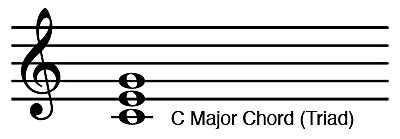
| SIDEBAR: From this point forward in the discussion of basic chord theory I'll refer to triad's as chords. If I discuss a chord with more than three, or fewer than three notes, I'll specify that. |
An interval is the distance between two notes. Chords are two stacked intervals that are thirds. These thirds can be major or minor.
A third is major if there are 5 half steps between the two notes (you must count the first note and the last note). For example, to count the half-steps from C to E you count like this: C (1), C# (2), D (3), D# (4), E (5). So, the first interval in our C-Major (above) is a major third.
A third is minor if there are 4 half steps between the two notes. In our C-Major example (the illustration above), the distance from E to G is four: E (1), F (2), F# (3), G (4), so the second interval is a minor third.
There are four possible combinations of major and minor thirds. Each combination creates a particular type of chord. The combinations are:
- Major Third + Minor Third = Major Chord
- Minor Third + Major Third = Minor Chord
- Major Third + Major Third = Augmented Chord
- Minor Third + Minor Third = Diminished Chord
Chords, Scales & Key Relationships
Once you understand basic chord theory, you may want to write a song. When a songwriter sits down to put music to paper, one of the decisions made is "what key should the song be in?" The key defines the set of notes used throughout the song. There are three general ways for the player to determine the key of a song:
- The key may be written at the top of the music notation
- The first and last chord are nearly always the same as the key
- Read the sharps, or flats, at the beginning of the song.
Here's an example:
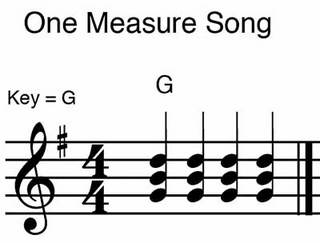
All three clues exist in this One Measure Song.
First, the only accidental (the symbols for sharps, flats, and naturals are called accidentals) is an F#. The G scale has only one sharp, the F#. So, this simple song must be in G.
Second, the key is identified by the author with: "Key = G".
Finally, the first chord (and the last, since there is only one measure) is a G-Major.
Now that we know the key, we also know which notes are most likely to appear in the melody and harmony... they will be the notes of the G-Major scale:
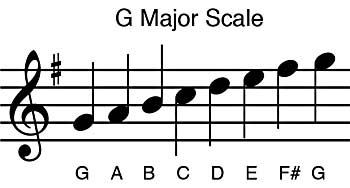
In addition to letter names (G..A..B.. etc.) each note in a scale is also assigned a Roman Numeral. These are helpful when transposing keys, which we'll examine shortly.
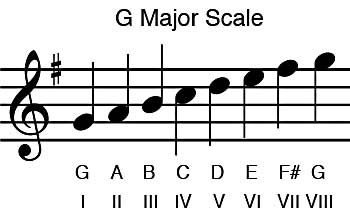
Some of the keys to understanding basic chord theory:
Scales, Note-names, and Roman Numerals
Chord Progressions (Chords In Songs)
Chord progressions, the series of chords used in a song, are built on the scale, or Key, of the song. Most popular music uses the I - IV - V chords. If the song is in the key of G, the chords used most frequently will be G (the I chord), C (the IV chord) and D (the V chord).
Examples of three chord songs:
- "Bad Moon Rising" by Credence Clearwater Revival
- "Jingle Bells"
- "Hound Dog" by Elvis Presley
- "Louie, Louie" by The Kingsmen
- "Margaritaville" by Jimmy Buffet
- "Wild Thing" by The Troggs
- and many, many more...
There are a number of books for guitarists with such simple-to-play songs, such as "The Guitar 3 Chord Songbook," and "The Three Chord Guitar Big Book
."
Transposing
Suppose you want to play "Louie, Louie"? Suppose further that the copy you find uses the key of G, but your voice doesn't match the key of G? You know from experience that songs in the key of C work best for your voice. Or, suppose you find a song in the key of C, which uses the chords C - F - G, but you have a hard time playing an F-chord?
Now what?
With a little basic chord theory you can solve these problems by transposing the song to the new key!
Transposing simply means changing the key of the song.
For either problem, you could decide to play the song in the key of D. How?
Remember that most popular music works on standard chord progressions... the I - IV - V chords. For the key of G, we've seen that these are the chords G - C - D.
To transpose a song to a new key, look up the scale for the key. Then find the I, IV and V notes. These are your new chords!
Here are the most common major scales:
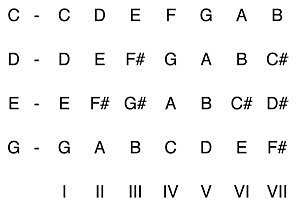
Want to play the song in C? Your chords are C - F - G.
Want to play in D? The chords are D - G - A.
How about in E? Use chords E - A - B.
Want to try G? Use chords G - C - D.
What's Next?
If you've enjoyed this article on basic chord theory, you may also enjoy my article on Basic Music Theory.


